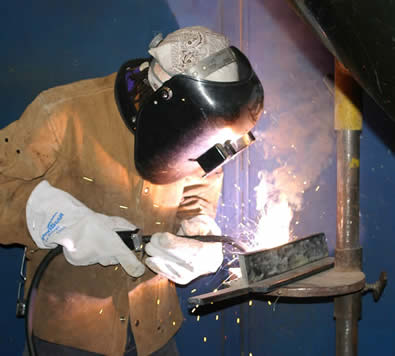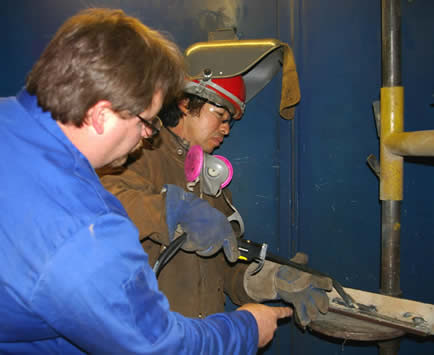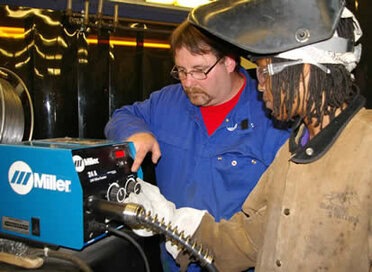Strong Bond and Strong Community at San Diego Continuing Education
The economy is in bad shape right now, but when it improves, the graduates of San Diego Continuing Education’s welding program will be well positioned to fulfill the need for skilled welders.

Now in its 35th year, the school focuses on adult education for unemployed and underemployed San Diego-area residents. Its curriculum is narrowly tailored to the needs of local industries — specifically shipbuilding, construction and manufacturing. The school provides free training to any California resident and currently has 96 students and a waiting list of an additional 58 people.
“Our program is set up to provide the student with experience on the same types of joint configurations, metal types and welding processes that they’re going to need when they enter the workforce,” explains welding instructor Bill Borinski.
The program, which spans a minimum of 600 hours over 24 weeks, also prepares the students with the skills to obtain an AWS D1.1 (American Welding Society) Unlimited Certification by passing a visual and x-ray weld evaluation. Even with the school’s focused, industry-driven curriculum, there is still a vast amount of knowledge and skills to impart to the students, and the school strives to make every minute count.
That, explains Borinski, is why it is so important for the school to have durable, time-saving welding equipment. “Downtime in business costs money — for us it costs knowledge,” he says. “If a student’s equipment is down, then he’s not learning. Our students have enough to concentrate on as it is, they shouldn’t have to worry about whether their equipment is working properly or not.”
The school recently converted its welding labs to Bernard™ Q-Gun™ and Dura-Flux™ MIG Guns and Centerfire™ Consumables to prevent such problems. The guns and consumables came packaged with the school’s new power sources and wire feeders, and Borinski said he’s been very satisfied with the results. The program has been running the guns for 12 hours a day, four days a week, and there hasn’t been a single malfunction. The Centerfire consumables system has reduced student downtime and frustration, while also improving weld quality.
Partnering for Success
In this open-enrollment program, students work on the material at their own pace until they master the skills required to graduate. New classes, which meet for 6.25 hours a day, four days a week, begin every month, and students can stop and start the program at their discretion.
Students learn an AWS-certified curriculum in self-shielded and gas-shielded flux-cored welding on 3/8- to 1-inch mild steel using E70T-1 and E71T-8 welding wire. Students briefly learn the GMAW process, but the program spends the majority of its time providing specific skills that are needed immediately in local industries. They focus on building proficiency in all welding positions on butt, corner and T-joints.
The school uses Bernard Q-Gun MIG Guns for its gas-shielded flux-cored and MIG training. Borinski noted that the gun’s curved handle reduces his students’ muscle fatigue after welding for long periods of time, and that the guns also improve their mechanical leverage, making it easier for the students to hold the guns in flat and horizontal welding positions.
“What my students and I love about the Q-Gun handle is that when you put it in your hand, it’s already in a position to weld,” Borinski said. “If the MIG gun is putting strain on my students’ wrists, they’re going to be sore and miserable by the end of the day and they’ll probably lose some of their enthusiasm for a career in welding.”

The Centerfire system further reduces his students’ educational downtime and frustration levels, Borinski said. By using a threadless contact tip with a large diameter tapered base that fits snugly into the diffuser and is locked in place by the nozzle, the Centerfire consumables make it nearly impossible for students to set incorrect contact tip recesses or for the tip to come loose inside the nozzle.
“With our old brand of consumables, if we didn’t screw the contact tips in properly they would come loose and literally fly out of the end of the gun. That can really add to the frustration of a beginning welder,” Borinski said.
While he is pleased with the guns and consumables, Borinski noted that it’s Bernard’s customer service that will keep him as a customer when their equipment eventually needs to be replaced.
“To us, a gun is a gun,” Borinski said. “We can figure out on our own how it operates. Still, we were really impressed when a Bernard representative came out and offered to exchange any of our guns for free if the stock model didn’t perfectly fit our lab set ups.”
Bernard’s Gun Exchange Program allows any one who receives a standard Q-Gun or Dura-Flux MIG Gun as part of a power source or wire feeder package to exchange the unused gun for a new gun with different cable length, neck, handle or trigger configurations.
Bernard also provided Borinski with product information and support prior to and following his purchase to ensure the guns and consumables he ordered would meet his needs.
“Sometimes the educational community gets sheltered from a lot of the outside activities that are going on. We don’t get exposure to the different equipment options that are out there,” Borinski said. “When Heidi Ewoldt, Bernard’s Inside Technical Sales Manager, called us and spent time explaining all of the equipment options and configurations available, it told us that Bernard wanted more than a quick sale. They were committed to our success.”
“We’re running some pretty hot, high-amperage applications here,” Borinski said, “and we have had zero failures — zero internal issues, zero electrical issues. We haven’t even needed to change the liners on some of the guns.”
Reaching out to the Community

Like Bernard, San Diego Continuing Education understands the value of strong partnerships and adapting its products to its customers’ needs. In order to meet the evolving demands of area industries, Borinski meets annually with an advisory committee composed of business and union leaders to discuss the skills and knowledge they look for in new employees.
“If we taught what we wanted to teach and not what the employers in the area need, then we’re sending them people they can’t use and wasting our students’ time,” Borinski continued. “We must have our pulse on the industry in order to be a relevant educational institution.”
In the last few years, Borinski said, the advisory committee has been asking for employees with “soft skills,” such as blueprint reading, teamwork training, lean manufacturing processes and other skills that go beyond laying a weld bead.
“The job market is very competitive now,” Borinski said, “and those students with additional skills, who can add value to the organization, are going to have a significant advantage during the interview process.”
That’s why the school partnered with the AWS to form a curriculum that provides students with the knowledge and skills they need to become AWS Certified Unlimited in FCAW upon graduation. The unlimited designation is a guarantee that the student can perform code-quality welds in the 1-G, 2-G, 3-G and 4-G positions using the FCAW process. This certification, combined with the schools blue print reading and teamwork curriculum, gives graduates a strong advantage when applying to one of the area unions, Borinski said.
The school’s approach to welder training has resulted in numerous opportunities for its graduates in area businesses. One example is the school’s partnership with General Dynamics NASSCO, one of the San Diego’s largest employers. Through the partnership, General Dynamics NASSCO has hired over 400 of the program’s graduates in recent years.
The main reason San Diego Continuing Education tried the Bernard guns and consumables was that they came packaged with the wire feeders and power sources the school purchased. Still, after using them without a single failure for the last 18 months, Borinski said one of the first questions he will ask when purchasing new equipment will be whether they accept Bernard guns and consumables. Luckily for him, Bernard’s products are adaptable to almost all major power source and wire feeder brands.